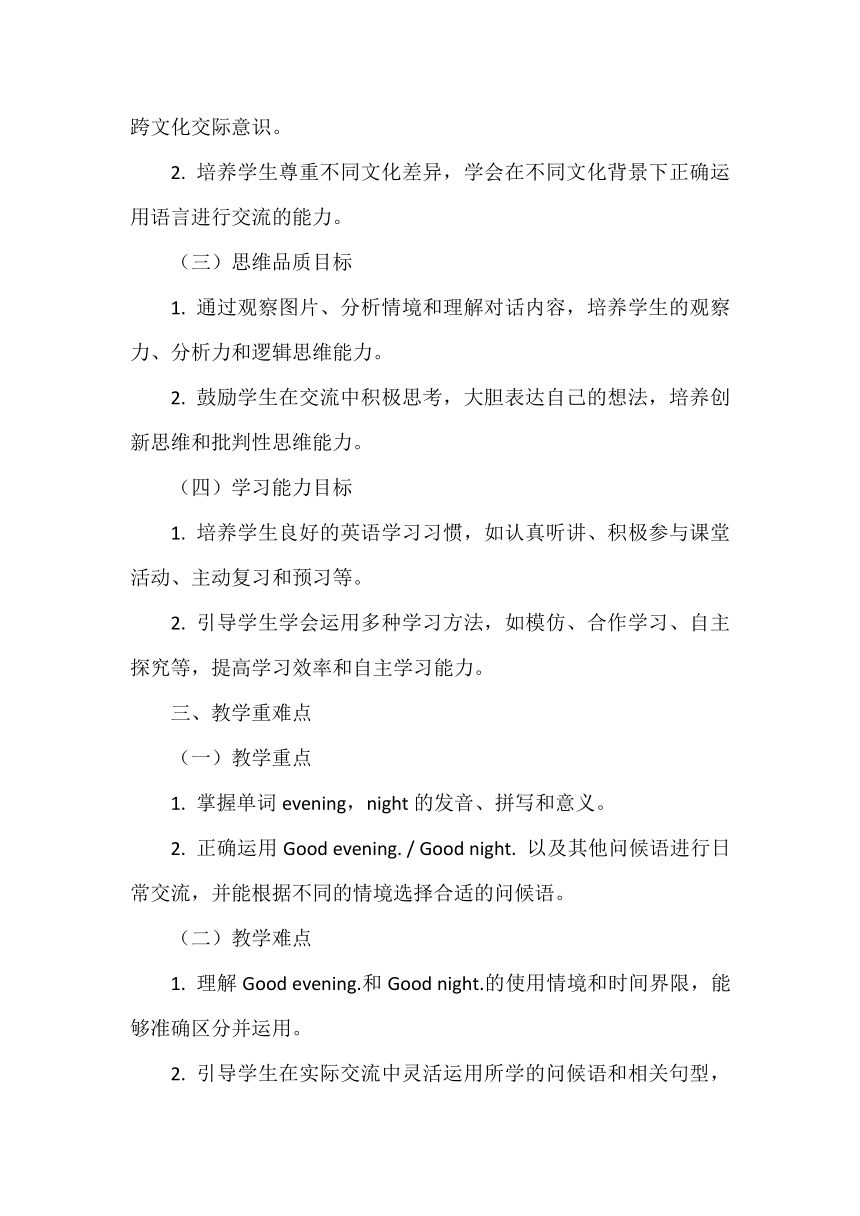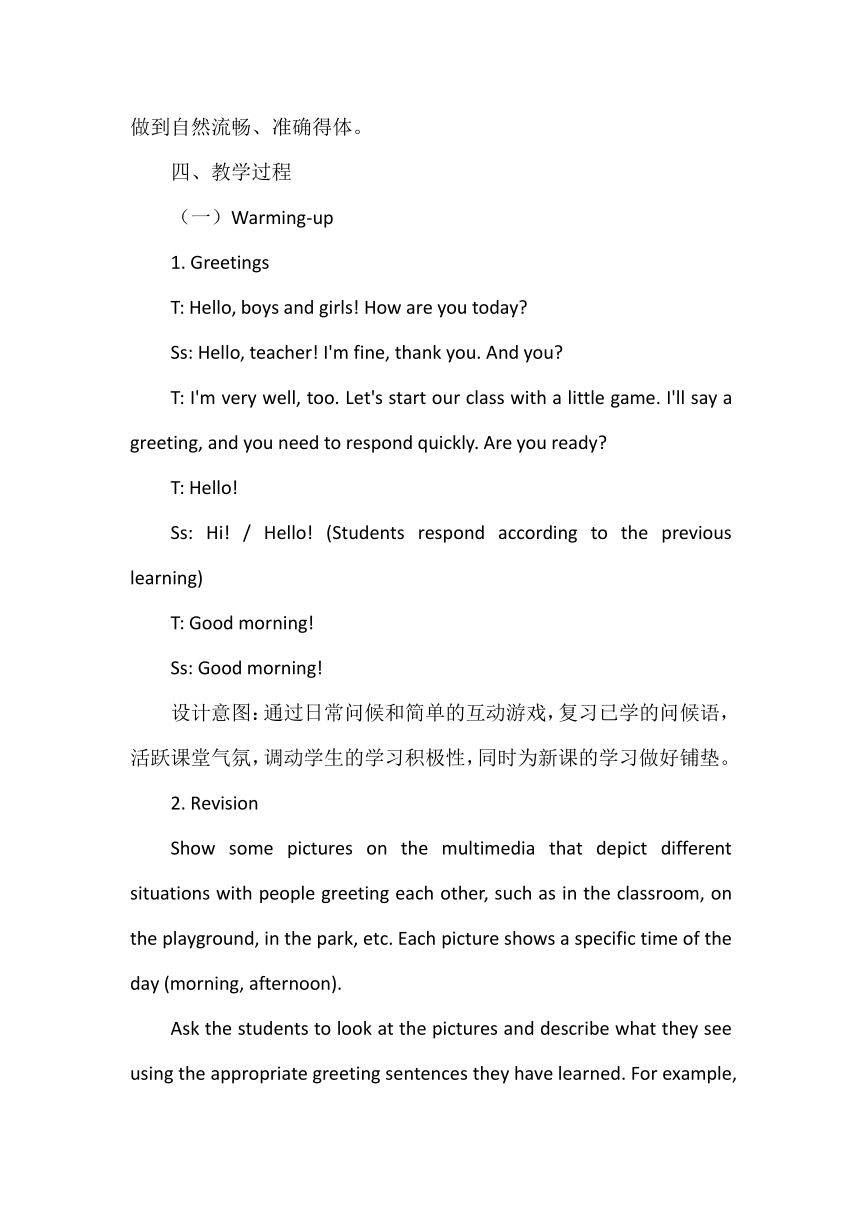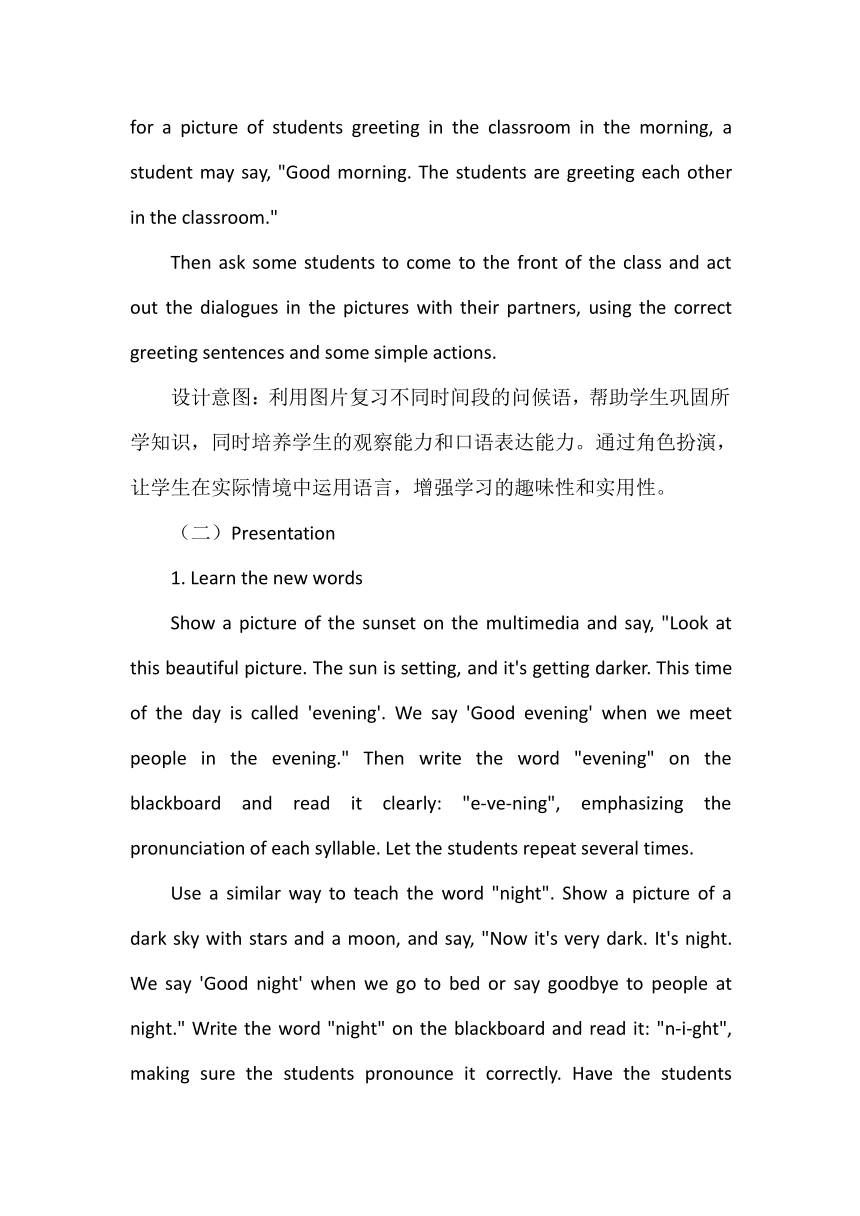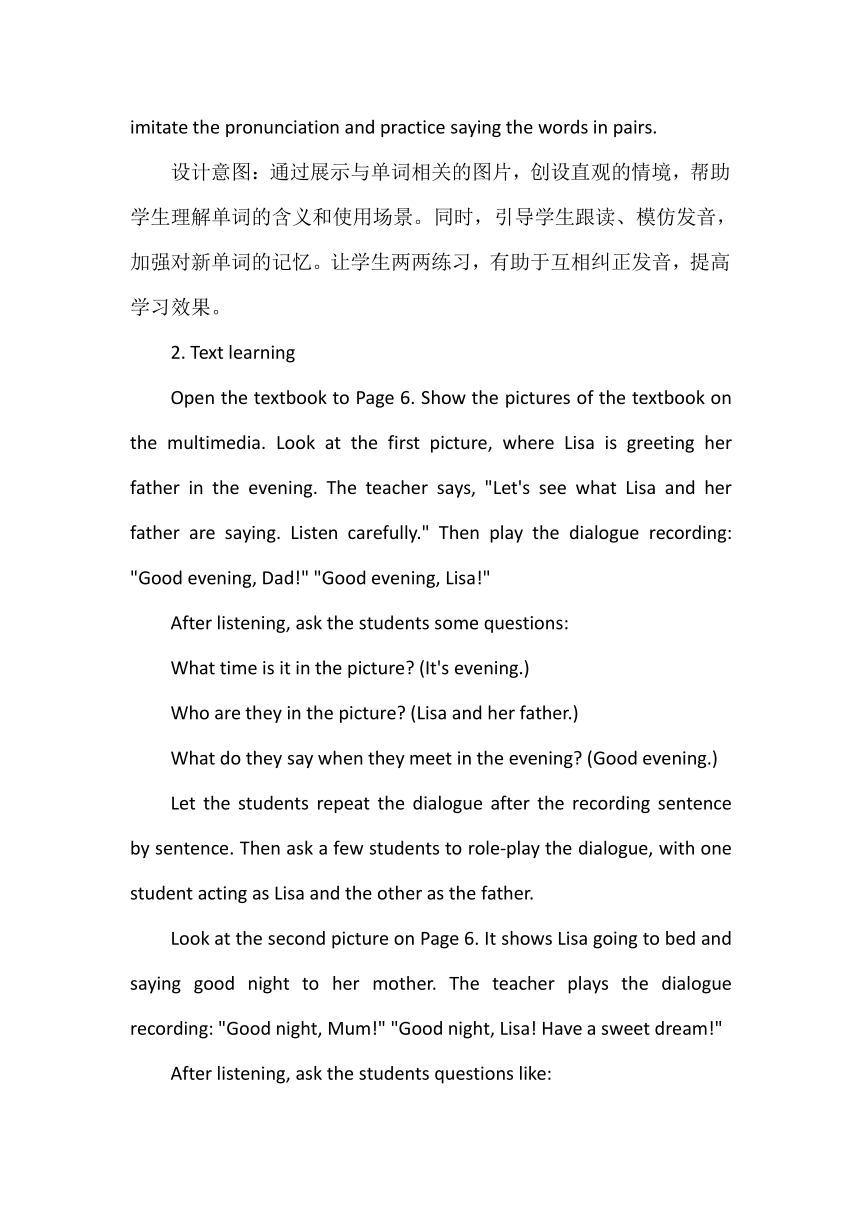Unit 1 Greetings Lesson 3 教案(含反思)
文档属性
| 名称 | Unit 1 Greetings Lesson 3 教案(含反思) |  | |
| 格式 | docx | ||
| 文件大小 | 24.6KB | ||
| 资源类型 | 教案 | ||
| 版本资源 | 人教精通版(三年级起点) | ||
| 科目 | 英语 | ||
| 更新时间 | 2024-10-27 16:25:40 | ||
图片预览





文档简介
Unit1《Greetings:Lesson 3》(教学设计)-2024-2025学年
人教精通版(2024)小学英语三年级上册
一、教材内容
(一)教学内容
本课时是人教精通版(2024)小学英语三年级上册Unit1《Greetings》中的《Lesson 3》。主要围绕问候语“Good evening.”“Good night.”以及复习之前学过的问候语和自我介绍展开。教材通过生动有趣的图片和简单的对话,引导学生在不同的时间段使用恰当的问候语,并进一步巩固和运用所学的英语表达进行交流。
(二)教材分析
本单元的主题是“问候”,在前两课的基础上,《Lesson 3》继续拓展了问候语的学习,丰富了学生在日常生活中用英语进行交流的表达方式。教材内容注重情境创设,贴近学生的生活实际,有助于学生理解和运用语言知识。同时,通过复习和巩固,帮助学生加深对已学知识的记忆,提高语言综合运用能力。
二、核心素养目标
(一)语言能力目标
1. 学生能够准确听、说、读、写单词:evening,night。
2. 学生能够熟练运用句型:Good evening. / Good night. 以及之前学过的Hello! / Hi! I'm... This is...在不同的情境中进行问候和交流。
(二)文化意识目标
1. 了解英语中不同时间段问候语的文化背景和使用习惯,增强跨文化交际意识。
2. 培养学生尊重不同文化差异,学会在不同文化背景下正确运用语言进行交流的能力。
(三)思维品质目标
1. 通过观察图片、分析情境和理解对话内容,培养学生的观察力、分析力和逻辑思维能力。
2. 鼓励学生在交流中积极思考,大胆表达自己的想法,培养创新思维和批判性思维能力。
(四)学习能力目标
1. 培养学生良好的英语学习习惯,如认真听讲、积极参与课堂活动、主动复习和预习等。
2. 引导学生学会运用多种学习方法,如模仿、合作学习、自主探究等,提高学习效率和自主学习能力。
三、教学重难点
(一)教学重点
1. 掌握单词evening,night的发音、拼写和意义。
2. 正确运用Good evening. / Good night. 以及其他问候语进行日常交流,并能根据不同的情境选择合适的问候语。
(二)教学难点
1. 理解Good evening.和Good night.的使用情境和时间界限,能够准确区分并运用。
2. 引导学生在实际交流中灵活运用所学的问候语和相关句型,做到自然流畅、准确得体。
四、教学过程
(一)Warming-up
1. Greetings
T: Hello, boys and girls! How are you today
Ss: Hello, teacher! I'm fine, thank you. And you
T: I'm very well, too. Let's start our class with a little game. I'll say a greeting, and you need to respond quickly. Are you ready
T: Hello!
Ss: Hi! / Hello! (Students respond according to the previous learning)
T: Good morning!
Ss: Good morning!
设计意图:通过日常问候和简单的互动游戏,复习已学的问候语,活跃课堂气氛,调动学生的学习积极性,同时为新课的学习做好铺垫。
2. Revision
Show some pictures on the multimedia that depict different situations with people greeting each other, such as in the classroom, on the playground, in the park, etc. Each picture shows a specific time of the day (morning, afternoon).
Ask the students to look at the pictures and describe what they see using the appropriate greeting sentences they have learned. For example, for a picture of students greeting in the classroom in the morning, a student may say, "Good morning. The students are greeting each other in the classroom."
Then ask some students to come to the front of the class and act out the dialogues in the pictures with their partners, using the correct greeting sentences and some simple actions.
设计意图:利用图片复习不同时间段的问候语,帮助学生巩固所学知识,同时培养学生的观察能力和口语表达能力。通过角色扮演,让学生在实际情境中运用语言,增强学习的趣味性和实用性。
(二)Presentation
1. Learn the new words
Show a picture of the sunset on the multimedia and say, "Look at this beautiful picture. The sun is setting, and it's getting darker. This time of the day is called 'evening'. We say 'Good evening' when we meet people in the evening." Then write the word "evening" on the blackboard and read it clearly: "e-ve-ning", emphasizing the pronunciation of each syllable. Let the students repeat several times.
Use a similar way to teach the word "night". Show a picture of a dark sky with stars and a moon, and say, "Now it's very dark. It's night. We say 'Good night' when we go to bed or say goodbye to people at night." Write the word "night" on the blackboard and read it: "n-i-ght", making sure the students pronounce it correctly. Have the students imitate the pronunciation and practice saying the words in pairs.
设计意图:通过展示与单词相关的图片,创设直观的情境,帮助学生理解单词的含义和使用场景。同时,引导学生跟读、模仿发音,加强对新单词的记忆。让学生两两练习,有助于互相纠正发音,提高学习效果。
2. Text learning
Open the textbook to Page 6. Show the pictures of the textbook on the multimedia. Look at the first picture, where Lisa is greeting her father in the evening. The teacher says, "Let's see what Lisa and her father are saying. Listen carefully." Then play the dialogue recording: "Good evening, Dad!" "Good evening, Lisa!"
After listening, ask the students some questions:
What time is it in the picture (It's evening.)
Who are they in the picture (Lisa and her father.)
What do they say when they meet in the evening (Good evening.)
Let the students repeat the dialogue after the recording sentence by sentence. Then ask a few students to role-play the dialogue, with one student acting as Lisa and the other as the father.
Look at the second picture on Page 6. It shows Lisa going to bed and saying good night to her mother. The teacher plays the dialogue recording: "Good night, Mum!" "Good night, Lisa! Have a sweet dream!"
After listening, ask the students questions like:
What is Lisa doing in the picture (She is going to bed.)
What time is it probably (It's night.)
What do they say when Lisa goes to bed (Good night.)
Explain the meaning and usage of "Good evening." and "Good night." in detail, emphasizing the difference in the time when they are used. For example, "Good evening" is usually used from around sunset to bedtime, while "Good night" is used when people are going to sleep or saying goodbye at night.
Have the students repeat the dialogues several times, paying attention to the pronunciation and intonation, and the appropriate use of the new words and sentences.
设计意图:通过教材图片和录音,引导学生进入对话情境,理解课文内容。提问环节帮助学生梳理关键信息,加深对新知识的理解。角色扮演活动让学生在实际情境中运用所学的问候语,提高口语表达能力和交际能力。详细解释“Good evening.”和“Good night.”的使用情境和时间界限,有助于学生准确理解和运用,避免在实际交流中出现错误。
(三)Practice
1. Group practice
Divide the students into groups of four. Each group is given a set of cards with different times of the day written on them (morning, afternoon, evening, night) and some pictures that show people greeting in different situations. The students take turns to pick a card and a picture, and then make a dialogue using the appropriate greeting sentence according to the time and situation on the card and picture. For example, if a student picks the "evening" card and a picture of two friends meeting on the street, he/she can say, "Good evening. Nice to see you." The other student in the group responds accordingly.
The teacher goes around the groups to observe and provide guidance. Encourage the students to use creative dialogues and pay attention to the correct pronunciation and grammar. After a while, ask some groups to present their dialogues in front of the class. Give positive feedback and rewards to the groups that perform well.
设计意图:小组练习可以增加学生的参与度和开口说英语的机会。通过时间卡片和图片的设置,创设不同的情境,让学生在实践中熟练掌握不同时间段的问候语,培养学生的语言运用能力和合作能力。教师的巡视和指导有助于及时纠正学生的错误,提高练习效果。小组展示可以增强学生的自信心和表现力,同时也为其他学生提供学习的榜样。
2. Listen and draw
The teacher says some sentences, such as "It's morning. Draw a sun rising in the sky." "It's afternoon. Draw a boy playing football in the park." "It's evening. Draw a family having dinner at the table." "It's night. Draw a little girl sleeping in her bed with a teddy bear beside her." The students listen and draw according to the teacher's instructions.
After they finish drawing, ask the students to show their pictures and describe what they have drawn using the appropriate greeting sentences. For example, a student may say, "Good morning. I drew a sun rising. It's a beautiful morning." This activity can help students better understand the meaning and usage of the words related to different times of the day, and also train their listening and drawing skills.
设计意图:通过听指令画图的活动,将语言学习与绘画相结合,增加学习的趣味性。学生在听和画的过程中,需要理解并运用与时间相关的词汇和问候语,从而加深对知识的记忆和理解。展示和描述图片的环节可以锻炼学生的口语表达能力和综合运用语言的能力。
(四)Production
1. Make a story
Ask the students to work in pairs and create a short story using the greeting sentences they have learned. The story should have a clear beginning, middle, and end, and involve different times of the day and people greeting each other in different situations. For example, a student may create a story like this: "In the morning, Tom goes to school and meets his friend Jerry. They say 'Good morning' to each other. In the afternoon, they play basketball together and greet their classmates with 'Hi!' When it's evening, Tom goes home and says 'Good evening' to his parents. At night, he goes to bed and says 'Good night' to his teddy bear."
Give the students enough time to write and discuss their stories. Then ask some pairs to come to the front of the class and tell their stories to the whole class. Encourage other students to listen carefully and ask questions or give comments.
设计意图:让学生创编故事可以培养学生的创造力和语言综合运用能力。通过设定故事的要求,让学生在编写过程中运用不同时间段的问候语和相关句型,将所学知识融会贯通。讲述故事和互动环节可以提高学生的口语表达能力和自信心,同时也能培养学生的倾听和评价能力。
2. Role-play activity: "A Day in My Life"
Divide the class into several groups. Each group chooses a scenario that represents a day in someone's life, such as a school day, a weekend day at home, or a day out with friends. The students in each group need to act out the different activities and interactions that happen during the day, using the appropriate greeting sentences and other expressions they have learned.
For example, in a school day scenario, students can act out greeting their teachers and classmates in the morning, having conversations during recess and lunchtime (using Hello! / Hi!), and saying goodbye in the afternoon. At home in the evening, they can show greeting their family members and going to bed at night with "Good night."
After the groups have prepared and rehearsed, they perform their role-plays in front of the class. The teacher and other students can watch and evaluate the performances based on the use of language, creativity, and the overall presentation.
设计意图:通过角色扮演活动,让学生模拟真实生活中的场景,深入体验语言在不同情境中的运用。这种活动可以提高学生的语言运用能力、团队合作能力和表演能力。同时,让学生在活动中感受英语学习的乐趣和实用性,增强学习的动力和兴趣。
(五)Summary
1. Review the words and sentences
The teacher shows the word cards of "evening" and "night" again and asks the students to read aloud and spell them. Then ask some students to use these words to make sentences, such as "Good evening. I'm going to watch TV with my parents this evening." or "Good night. I'm going to sleep now."
Review all the greeting sentences learned in this unit: Hello! / Hi! Good morning. / Good afternoon. / Good evening. / Good night. I'm... This is... Have the students summarize the situations in which each greeting sentence is used. For example, they can say that "Hello!" and "Hi!" can be used at any time when meeting people casually, "Good morning." is used in the morning, "Good afternoon." in the afternoon, "Good evening." in the evening before bedtime, and "Good night." when going to sleep or saying goodbye at night.
设计意图:通过复习单词和句子,巩固学生所学的知识,强化记忆。让学生总结问候语的使用情境,有助于他们更好地理解和运用这些语言知识,提高语言运用的准确性和得体性。
2. Cultural awareness
Discuss with the students the cultural differences in greeting customs between different countries. For example, in some Western countries, people usually kiss or hug when greeting close friends or family members, while in China, we may shake hands or nod. Also, the appropriate distance and eye contact when greeting may vary in different cultures.
Encourage the students to be aware of these cultural differences and respect them when communicating with people from different backgrounds. Remind them that learning a language also means learning about the culture behind it.
设计意图:在语言教学中培养学生的文化意识,让学生了解不同文化背景下的问候习俗差异,拓宽学生的国际视野,增强跨文化交际能力。引导学生尊重文化差异,培养学生的文化包容和理解能力,有助于学生在未来的国际交流中更好地适应和融入不同的文化环境。
(六)Homework
1. Listen to the dialogue on Page 6 of the textbook for five times and imitate the pronunciation and intonation.
设计意图:通过听读课文对话,巩固课堂所学的语音、语调知识,培养学生的语感,提高学生的听力和口语表达能力。
2. Observe the people around you and record the times and situations when they use different greeting sentences. You can write them down in a small notebook. Try to use the English greeting sentences you have learned to greet your family and friends at the appropriate times.
设计意图:将英语学习延伸到生活实际中,让学生在观察和记录中进一步加深对不同问候语使用情境的理解。同时,鼓励学生在生活中积极运用英语进行交流,提高语言实践能力,增强学习的成就感和兴趣。
五、课堂总结
在本节课中,我们学习了新的问候语“Good evening.”和“Good night.”,并复习了之前学过的其他问候语和相关句型。通过多种形式的练习和活动,同学们积极参与,对不同时间段的问候语有了更深入的理解和掌握。我们还了解了英语中问候语的文化背景和使用习惯,知道了在不同文化中问候方式可能存在差异。希望同学们在今后的学习和生活中,能够灵活运用所学的英语问候语,与他人友好交流,同时尊重不同的文化习俗。大家在课后要认真完成作业,继续巩固所学知识,不断提高自己的英语水平。
六、教学反思
在教学过程中,通过图片、情境创设和多种互动活动,学生对新知识的学习兴趣较高,能够积极参与课堂练习和角色扮演等活动。大部分学生能够较好地掌握“evening”和“night”这两个单词以及“Good evening.”和“Good night.”这两个问候语的用法,但在实际运用中,仍有部分学生对不同问候语的使用情境区分不够清晰,需要在今后的教学中加强针对性的练习和巩固。在文化意识培养方面,学生表现出了浓厚的兴趣,积极参与讨论,但对于文化差异的理解还需要进一步深化和拓展。在教学活动的组织上,小组活动和创编故事等环节有效地促进了学生的合作学习和语言综合运用能力,但在时间把控上还需要更加精准,以确保每个教学环节都能充分展开。在今后的教学中,我将继续关注学生的学习情况,优化教学方法和活动设计,注重培养学生的语言实际运用能力和跨文化交际意识,提高教学质量。
人教精通版(2024)小学英语三年级上册
一、教材内容
(一)教学内容
本课时是人教精通版(2024)小学英语三年级上册Unit1《Greetings》中的《Lesson 3》。主要围绕问候语“Good evening.”“Good night.”以及复习之前学过的问候语和自我介绍展开。教材通过生动有趣的图片和简单的对话,引导学生在不同的时间段使用恰当的问候语,并进一步巩固和运用所学的英语表达进行交流。
(二)教材分析
本单元的主题是“问候”,在前两课的基础上,《Lesson 3》继续拓展了问候语的学习,丰富了学生在日常生活中用英语进行交流的表达方式。教材内容注重情境创设,贴近学生的生活实际,有助于学生理解和运用语言知识。同时,通过复习和巩固,帮助学生加深对已学知识的记忆,提高语言综合运用能力。
二、核心素养目标
(一)语言能力目标
1. 学生能够准确听、说、读、写单词:evening,night。
2. 学生能够熟练运用句型:Good evening. / Good night. 以及之前学过的Hello! / Hi! I'm... This is...在不同的情境中进行问候和交流。
(二)文化意识目标
1. 了解英语中不同时间段问候语的文化背景和使用习惯,增强跨文化交际意识。
2. 培养学生尊重不同文化差异,学会在不同文化背景下正确运用语言进行交流的能力。
(三)思维品质目标
1. 通过观察图片、分析情境和理解对话内容,培养学生的观察力、分析力和逻辑思维能力。
2. 鼓励学生在交流中积极思考,大胆表达自己的想法,培养创新思维和批判性思维能力。
(四)学习能力目标
1. 培养学生良好的英语学习习惯,如认真听讲、积极参与课堂活动、主动复习和预习等。
2. 引导学生学会运用多种学习方法,如模仿、合作学习、自主探究等,提高学习效率和自主学习能力。
三、教学重难点
(一)教学重点
1. 掌握单词evening,night的发音、拼写和意义。
2. 正确运用Good evening. / Good night. 以及其他问候语进行日常交流,并能根据不同的情境选择合适的问候语。
(二)教学难点
1. 理解Good evening.和Good night.的使用情境和时间界限,能够准确区分并运用。
2. 引导学生在实际交流中灵活运用所学的问候语和相关句型,做到自然流畅、准确得体。
四、教学过程
(一)Warming-up
1. Greetings
T: Hello, boys and girls! How are you today
Ss: Hello, teacher! I'm fine, thank you. And you
T: I'm very well, too. Let's start our class with a little game. I'll say a greeting, and you need to respond quickly. Are you ready
T: Hello!
Ss: Hi! / Hello! (Students respond according to the previous learning)
T: Good morning!
Ss: Good morning!
设计意图:通过日常问候和简单的互动游戏,复习已学的问候语,活跃课堂气氛,调动学生的学习积极性,同时为新课的学习做好铺垫。
2. Revision
Show some pictures on the multimedia that depict different situations with people greeting each other, such as in the classroom, on the playground, in the park, etc. Each picture shows a specific time of the day (morning, afternoon).
Ask the students to look at the pictures and describe what they see using the appropriate greeting sentences they have learned. For example, for a picture of students greeting in the classroom in the morning, a student may say, "Good morning. The students are greeting each other in the classroom."
Then ask some students to come to the front of the class and act out the dialogues in the pictures with their partners, using the correct greeting sentences and some simple actions.
设计意图:利用图片复习不同时间段的问候语,帮助学生巩固所学知识,同时培养学生的观察能力和口语表达能力。通过角色扮演,让学生在实际情境中运用语言,增强学习的趣味性和实用性。
(二)Presentation
1. Learn the new words
Show a picture of the sunset on the multimedia and say, "Look at this beautiful picture. The sun is setting, and it's getting darker. This time of the day is called 'evening'. We say 'Good evening' when we meet people in the evening." Then write the word "evening" on the blackboard and read it clearly: "e-ve-ning", emphasizing the pronunciation of each syllable. Let the students repeat several times.
Use a similar way to teach the word "night". Show a picture of a dark sky with stars and a moon, and say, "Now it's very dark. It's night. We say 'Good night' when we go to bed or say goodbye to people at night." Write the word "night" on the blackboard and read it: "n-i-ght", making sure the students pronounce it correctly. Have the students imitate the pronunciation and practice saying the words in pairs.
设计意图:通过展示与单词相关的图片,创设直观的情境,帮助学生理解单词的含义和使用场景。同时,引导学生跟读、模仿发音,加强对新单词的记忆。让学生两两练习,有助于互相纠正发音,提高学习效果。
2. Text learning
Open the textbook to Page 6. Show the pictures of the textbook on the multimedia. Look at the first picture, where Lisa is greeting her father in the evening. The teacher says, "Let's see what Lisa and her father are saying. Listen carefully." Then play the dialogue recording: "Good evening, Dad!" "Good evening, Lisa!"
After listening, ask the students some questions:
What time is it in the picture (It's evening.)
Who are they in the picture (Lisa and her father.)
What do they say when they meet in the evening (Good evening.)
Let the students repeat the dialogue after the recording sentence by sentence. Then ask a few students to role-play the dialogue, with one student acting as Lisa and the other as the father.
Look at the second picture on Page 6. It shows Lisa going to bed and saying good night to her mother. The teacher plays the dialogue recording: "Good night, Mum!" "Good night, Lisa! Have a sweet dream!"
After listening, ask the students questions like:
What is Lisa doing in the picture (She is going to bed.)
What time is it probably (It's night.)
What do they say when Lisa goes to bed (Good night.)
Explain the meaning and usage of "Good evening." and "Good night." in detail, emphasizing the difference in the time when they are used. For example, "Good evening" is usually used from around sunset to bedtime, while "Good night" is used when people are going to sleep or saying goodbye at night.
Have the students repeat the dialogues several times, paying attention to the pronunciation and intonation, and the appropriate use of the new words and sentences.
设计意图:通过教材图片和录音,引导学生进入对话情境,理解课文内容。提问环节帮助学生梳理关键信息,加深对新知识的理解。角色扮演活动让学生在实际情境中运用所学的问候语,提高口语表达能力和交际能力。详细解释“Good evening.”和“Good night.”的使用情境和时间界限,有助于学生准确理解和运用,避免在实际交流中出现错误。
(三)Practice
1. Group practice
Divide the students into groups of four. Each group is given a set of cards with different times of the day written on them (morning, afternoon, evening, night) and some pictures that show people greeting in different situations. The students take turns to pick a card and a picture, and then make a dialogue using the appropriate greeting sentence according to the time and situation on the card and picture. For example, if a student picks the "evening" card and a picture of two friends meeting on the street, he/she can say, "Good evening. Nice to see you." The other student in the group responds accordingly.
The teacher goes around the groups to observe and provide guidance. Encourage the students to use creative dialogues and pay attention to the correct pronunciation and grammar. After a while, ask some groups to present their dialogues in front of the class. Give positive feedback and rewards to the groups that perform well.
设计意图:小组练习可以增加学生的参与度和开口说英语的机会。通过时间卡片和图片的设置,创设不同的情境,让学生在实践中熟练掌握不同时间段的问候语,培养学生的语言运用能力和合作能力。教师的巡视和指导有助于及时纠正学生的错误,提高练习效果。小组展示可以增强学生的自信心和表现力,同时也为其他学生提供学习的榜样。
2. Listen and draw
The teacher says some sentences, such as "It's morning. Draw a sun rising in the sky." "It's afternoon. Draw a boy playing football in the park." "It's evening. Draw a family having dinner at the table." "It's night. Draw a little girl sleeping in her bed with a teddy bear beside her." The students listen and draw according to the teacher's instructions.
After they finish drawing, ask the students to show their pictures and describe what they have drawn using the appropriate greeting sentences. For example, a student may say, "Good morning. I drew a sun rising. It's a beautiful morning." This activity can help students better understand the meaning and usage of the words related to different times of the day, and also train their listening and drawing skills.
设计意图:通过听指令画图的活动,将语言学习与绘画相结合,增加学习的趣味性。学生在听和画的过程中,需要理解并运用与时间相关的词汇和问候语,从而加深对知识的记忆和理解。展示和描述图片的环节可以锻炼学生的口语表达能力和综合运用语言的能力。
(四)Production
1. Make a story
Ask the students to work in pairs and create a short story using the greeting sentences they have learned. The story should have a clear beginning, middle, and end, and involve different times of the day and people greeting each other in different situations. For example, a student may create a story like this: "In the morning, Tom goes to school and meets his friend Jerry. They say 'Good morning' to each other. In the afternoon, they play basketball together and greet their classmates with 'Hi!' When it's evening, Tom goes home and says 'Good evening' to his parents. At night, he goes to bed and says 'Good night' to his teddy bear."
Give the students enough time to write and discuss their stories. Then ask some pairs to come to the front of the class and tell their stories to the whole class. Encourage other students to listen carefully and ask questions or give comments.
设计意图:让学生创编故事可以培养学生的创造力和语言综合运用能力。通过设定故事的要求,让学生在编写过程中运用不同时间段的问候语和相关句型,将所学知识融会贯通。讲述故事和互动环节可以提高学生的口语表达能力和自信心,同时也能培养学生的倾听和评价能力。
2. Role-play activity: "A Day in My Life"
Divide the class into several groups. Each group chooses a scenario that represents a day in someone's life, such as a school day, a weekend day at home, or a day out with friends. The students in each group need to act out the different activities and interactions that happen during the day, using the appropriate greeting sentences and other expressions they have learned.
For example, in a school day scenario, students can act out greeting their teachers and classmates in the morning, having conversations during recess and lunchtime (using Hello! / Hi!), and saying goodbye in the afternoon. At home in the evening, they can show greeting their family members and going to bed at night with "Good night."
After the groups have prepared and rehearsed, they perform their role-plays in front of the class. The teacher and other students can watch and evaluate the performances based on the use of language, creativity, and the overall presentation.
设计意图:通过角色扮演活动,让学生模拟真实生活中的场景,深入体验语言在不同情境中的运用。这种活动可以提高学生的语言运用能力、团队合作能力和表演能力。同时,让学生在活动中感受英语学习的乐趣和实用性,增强学习的动力和兴趣。
(五)Summary
1. Review the words and sentences
The teacher shows the word cards of "evening" and "night" again and asks the students to read aloud and spell them. Then ask some students to use these words to make sentences, such as "Good evening. I'm going to watch TV with my parents this evening." or "Good night. I'm going to sleep now."
Review all the greeting sentences learned in this unit: Hello! / Hi! Good morning. / Good afternoon. / Good evening. / Good night. I'm... This is... Have the students summarize the situations in which each greeting sentence is used. For example, they can say that "Hello!" and "Hi!" can be used at any time when meeting people casually, "Good morning." is used in the morning, "Good afternoon." in the afternoon, "Good evening." in the evening before bedtime, and "Good night." when going to sleep or saying goodbye at night.
设计意图:通过复习单词和句子,巩固学生所学的知识,强化记忆。让学生总结问候语的使用情境,有助于他们更好地理解和运用这些语言知识,提高语言运用的准确性和得体性。
2. Cultural awareness
Discuss with the students the cultural differences in greeting customs between different countries. For example, in some Western countries, people usually kiss or hug when greeting close friends or family members, while in China, we may shake hands or nod. Also, the appropriate distance and eye contact when greeting may vary in different cultures.
Encourage the students to be aware of these cultural differences and respect them when communicating with people from different backgrounds. Remind them that learning a language also means learning about the culture behind it.
设计意图:在语言教学中培养学生的文化意识,让学生了解不同文化背景下的问候习俗差异,拓宽学生的国际视野,增强跨文化交际能力。引导学生尊重文化差异,培养学生的文化包容和理解能力,有助于学生在未来的国际交流中更好地适应和融入不同的文化环境。
(六)Homework
1. Listen to the dialogue on Page 6 of the textbook for five times and imitate the pronunciation and intonation.
设计意图:通过听读课文对话,巩固课堂所学的语音、语调知识,培养学生的语感,提高学生的听力和口语表达能力。
2. Observe the people around you and record the times and situations when they use different greeting sentences. You can write them down in a small notebook. Try to use the English greeting sentences you have learned to greet your family and friends at the appropriate times.
设计意图:将英语学习延伸到生活实际中,让学生在观察和记录中进一步加深对不同问候语使用情境的理解。同时,鼓励学生在生活中积极运用英语进行交流,提高语言实践能力,增强学习的成就感和兴趣。
五、课堂总结
在本节课中,我们学习了新的问候语“Good evening.”和“Good night.”,并复习了之前学过的其他问候语和相关句型。通过多种形式的练习和活动,同学们积极参与,对不同时间段的问候语有了更深入的理解和掌握。我们还了解了英语中问候语的文化背景和使用习惯,知道了在不同文化中问候方式可能存在差异。希望同学们在今后的学习和生活中,能够灵活运用所学的英语问候语,与他人友好交流,同时尊重不同的文化习俗。大家在课后要认真完成作业,继续巩固所学知识,不断提高自己的英语水平。
六、教学反思
在教学过程中,通过图片、情境创设和多种互动活动,学生对新知识的学习兴趣较高,能够积极参与课堂练习和角色扮演等活动。大部分学生能够较好地掌握“evening”和“night”这两个单词以及“Good evening.”和“Good night.”这两个问候语的用法,但在实际运用中,仍有部分学生对不同问候语的使用情境区分不够清晰,需要在今后的教学中加强针对性的练习和巩固。在文化意识培养方面,学生表现出了浓厚的兴趣,积极参与讨论,但对于文化差异的理解还需要进一步深化和拓展。在教学活动的组织上,小组活动和创编故事等环节有效地促进了学生的合作学习和语言综合运用能力,但在时间把控上还需要更加精准,以确保每个教学环节都能充分展开。在今后的教学中,我将继续关注学生的学习情况,优化教学方法和活动设计,注重培养学生的语言实际运用能力和跨文化交际意识,提高教学质量。
同课章节目录
